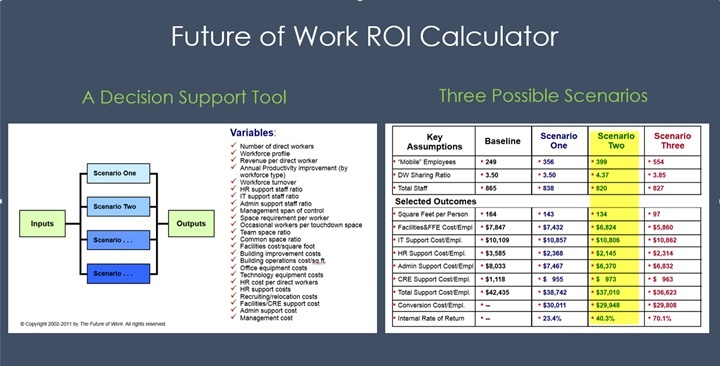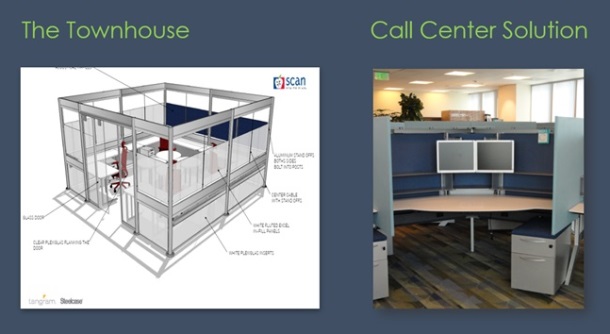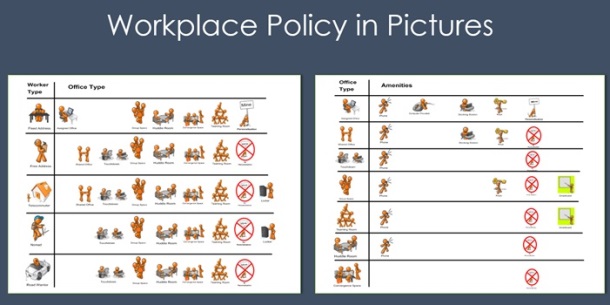Elevating FM through Workplace Mobility
by Diane Coles Levine — Elevating facility management into the board room can be challenging. One FM team at a Medicare insurance company in California not only did this, they created a business case for mobility that became a corporate-wide strategic initiative and won several global FM awards. This mobility project, also known as AWESOME (Alternate Workplaces Engaging Staff and Office Management Efficiencies) can be translated to any company, big or small, anywhere in the world
This Facilities team is not your typical old “status-quo” department. Instead, they led the way and affected the “triple bottom line” by improving work-life balance, reducing the company’s carbon footprint, and saving millions of dollars better put to use providing customers with quality health care.
The role of this FM department was somewhat atypical. However, the executive team explicitly tasked them with that goal to reduce overall operating costs while preserving the capability of the organization to attract and retain key talent today and be prepared for the future.
How did they do it?
The FM challenges faced by the department included:
- Constant changes in federal regulations that resulted in new staffing requirements
- Rapid growth in customer base causing increase in staffing
- Rapid Expansion into new areas
- Attracting and retaining talent was increasingly difficult
- Corporate facility at some risk due to long-term, inflexible lease and lack of space
- Space did not meet the company’s future vision and culture
- FM costs were high and growing
The project involved three major changes made:
- A flexible work program that now enables several hundred employees to work from home or other locations several days a week;
- An aggressive redesign and repurposing of the workplaces within the company’s corporate headquarters facility; and
- A fundamental redesign of the process by which individual and team workplaces are configured and provisioned.
The first step was to get buy-in from the C-Suite. The FM department did not wait for an invitation to present in front of the executive team, they actually called the meeting. In the first gathering, the team reviewed a return on investment (ROI) analysis of FM, HR and technology costs using an outside expert, Dr. Jim Ware from The Future of Work. The numbers spoke for themselves and showed a 40% return on investment for AWESOME as seen in Figure 1. This ROI definitely caught the attention of senior executives.
 Figure 1: Future of Work ROI Calculator. Scenario two shows 40% return on investment
Figure 1: Future of Work ROI Calculator. Scenario two shows 40% return on investment(Click on image to enlarge)
With the executive team interested in moving further along, the AWESOME team planned a second meeting where they asked the C-Suite one question about telecommuting, Figure 2. They then sat back, listened, didn’t say a word, and took copious notes.

Listening to the executives concerns gleaned a lot of information for the project team to mull over. The entire AWESOME program was developed by addressing all of the managerial issues through the project implementation plan, new policies and training programs. For example, the most common question “how do I know they are working when I can’t see them?’ was tackled by establishing performance measurements for staff working from home and reporting regularly on that data. How could the C-Suite say “No,” if all their apprehensions were dealt with in the design of the mobility program?
Aligning Workplace Design to Corporate Vision
The company was re-organizing the corporate structure intending to facilitate growth by expanding into new markets. To link the design to business strategy, the space needed to be less hierarchical, foster innovation, break down silos, improve productivity and increase corporate agility. The space needed the flexibility to meet demands of both residents and home office workers. Figure 3 is a summary of the shift in direction.

Given the rapidly changing healthcare environment, the facilities team needed to reconfigure furniture at a faster pace. User departments refused to wait more than a few weeks to re-plan cubicles. The company growth was moving at rapid pace, yet, its revenue derived from federal government programs was actually decreasing.
The AWESOME team re-engineered the modular furniture process to become more agile and cost-effective. They also re-aligned the workplace strategy with the company strategy and created a new flexible, agile and sustainable work environment in Figure 4.

Innovation in Design and Space Programming
Working with architect, Manuel Urquiza, The Urquiza Group Inc., the team developed a unique design concept to replace the traditional office cubicle. The design reflects the new corporate culture expressing openness, collaboration, and teaming. It includes creative spaces transcending traditional offices with more of a home office environment. The vision was transparency and freedom to work anywhere within “townhouses”, touchdown areas, phone booths, café style areas, informal teaming areas and the ability to move from any of these diverse environments to another, similar to how we move within our homes.
The FM team wanted complete flexibility to move furniture components quickly with no attachments to panels and minimal need for outside vendor services, so they created the “townhouse” idea, Figure 5, which is a “home” for four to six employees; the sizes range from 16×16 to 16×24 that can be re-configured within 24 hours.
The Call Center challenge was met by Kimball’s innovative HUM product. A 120° hexagon layout optimized what staff demanded, accessibility and collaboration. Aesthetically, HUM’s contemporary finish palette paired with its’ lightness in scale and high tech look produced a beautiful and productive work environment, Figure 5.

The AWESOME team changed the space programming process from designing using rigid office size standards to focusing on productivity, process improvement, teaming and collaboration. Townhouse resident teams were asked to design their work areas together using an interactive whiteboard called a Smartboard, Figure 6. The purpose of using this tool is threefold:
- To give staff “choice” in affecting the design of their space to improve productivity
- To make the group work as a team prior to moving into their townhouse
- To introduce staff to new interactive whiteboard technology

For employees who still work full-time in the corporate facility, having the power of choice in their workspace has been very well-received. This “self-design” approach has actually made the daunting task of space planning fun.
The Sales Department attribute the new space concept to playing a part in a 57% increase in sales their first year. Working in the townhouses has improved collaboration and customer processing in Telesales. A video about the new space concept with comments from former CEO Dave Schimdt and sales managers can be seen on YouTube at http://www.youtube.com/watch?v=k1A9AdVd0Ks.
Innovation in Change Management
With the economic downturn occurring during the project, the team needed to re-sell AWESOME to the executive team and show the savings on a continual basis. They convinced management to proceed regardless of the economy because the return on investment (ROI) was so high. The project even withstood a change in CEO, CFO and COO. It was the data collected throughout the course of the project that helped convince new executives to continue the program.
Executives and staff needed to understand why the company was making a large capital investment when salary increases were frozen. Transparency for all costs was required for the team, who regularly submitted numbers to recalculate and communicate the ROI.
The AWESOME team developed a change management plan to explain the reasons for the capital outlay. Once people understood the vision, cost savings and the future results, they began accepting the change which was communicated in several different ways including: through the CEO during “straight talk” meetings with all staff, company newsletters, videos, and individual department and team meetings. Figure 7 shows the cost savings for office provisioning before the change and after.

They say that “a picture is worth a thousand words.” The AWESOME group created a “Workplace Policy in Pictures,” Figure 8 to help staff understand new ways of working.

Changing the Role of FM and Impacting the Bottom Line
This project amply illustrates that the role of the FM is changing. Here are nine key areas which this role has evolved, along with the impact that each has had on the company’s triple bottom line; people, planet and profit.
Communication skills. AWESOME broke down silos between FM, Human Resources, and Information Technology departments; those functions are now aligned strategically. By empowering employees with the ability to “work anywhere,” coupled with the design of contemporary collaboration spaces that fosters creativity, innovation and break down silos, AWESOME has improved communication throughout the company.
Leadership and management. AWESOME allowed entry into the C-Suite for the FM leadership and also became the business case for a new strategic initiative within the company’s future vision. And, the AWESOME program’s achievements directly affected all executive bonuses!
Finance. The AWESOME program continues to reduce real estate operating costs by $1.1 million a year. In addition, the workplace redesign and reconfiguration efforts will produced over $7 million in operating cost reductions over five years. The project’s contribution to reduced administrative costs helps the company maintain its level of health care service to its customers without increasing their costs.
Human and environmental factors. Employee travel miles were reduced by 600,000. AWESOME has improved employee quality of life, attraction and retention, and employee engagement within the company. FM customer satisfaction survey results increased by 6%.
Operations. AWESOME introduced quantitative performance measurement practices into the company—measures now being rolled out and adopted for all employees in all departments. Project data shows that employees who work from home a minimum of two days per week are, on average, 18% more productive than they were before AWESOME. The creation of a new space concept and the re-engineering of the planning process have reduced workplace planning, configuration costs, and cycle times by 38%
Planning and project management. AWESOME demonstrates how FM, HRs, Business Development, and Information Technology working together can make a positive impact on the bottom line while also improving employee engagement, attraction, and retention, and preserving the capability to respond to changing market conditions.
Quality assessment and innovation. The impact of AWESOME has fundamentally changed how the company looks at its business model. The project has laid the foundation for entry into new markets by putting in place key processes to promote corporate agility and simplify the organizational impacts of geographic expansion using a strategy “Playbook” created by FM, HR, Business Development and IT.
Real estate. The density of occupation in the corporate facility increased by 16% reducing space and the need for additional real estate, saving approximately $1.1 million annually in rent.
Technology. To create the ability to “work anywhere,” AWESOME prompted new technology initiatives such as wireless networks within corporate facilities, increased bandwidth availability, and a movement to laptops, cell phones, IP Soft Phone, web meetings, instant messaging, and interactive electronic whiteboards.
Conclusion
The outcome of the AWESOME project has moved Facilities Management into a leadership position focused on flexibility, sustainability, and agility, and it positions the company to respond quickly to market pressures. While this solution worked for one company, it is not meant to be a one-size fits all. Every company is different and the workplace strategy should reflect the organizations mission, vision, culture and strategic plan.
More global case studies like this can be found in Work on the Move: Driving Strategy and Change in Workplaces published by the IFMA Foundation. Chapters 9 and Chapter 11 discuss how mobility is changing the role of FM. Over 20 case studies are showcased in Chapter 10. http://www.ifma.org/know-base/fm-knowledge-base/knowledge-base-details/work-on-the-move—driving-strategy-and-change-in-workplaces
Diane Coles Levine is the Executive Director of the IFMA Foundation. Previously, she was the founder and managing partner at Workplace Management Solutions. She served on the IFMA Board of Directors, is Past Chair of the IFMA Foundation and was named the 2015 IFMA Corporate Real Estate Council Distinguished Member. She is an international speaker and guest lecturer at Vienna University of Technology and MIT Professional Education Programs. Diane is co-editor and author of Work on the Move.